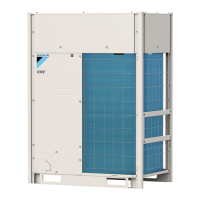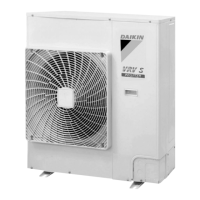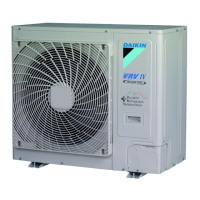20 | Configuration
Installer and user reference guide
67
FXMQ-A
VRV system air conditioner
4P701548-1 – 2022.07
Setting: Air volume when thermostat control is OFF
This setting must correspond with the needs of the user. It determines the fan
speed of the indoor unit during thermostat OFF condition.
1 If you have set the fan to operate, set the air volume speed:
If you want… Then
(1)
M SW —
During thermostat
OFF at cooling
operation
LL
(2)
12 (22) 6 01
Setup volume
(2)
02
OFF
(a)
03
Monitoring 1
(2)
04
Monitoring 2
(2)
05
During thermostat
OFF at heating
operation
LL
(2)
12 (22) 3 01
Setup volume
(2)
02
OFF
(a)
03
Monitoring 1
(2)
04
Monitoring 2
(2)
05
(a)
Only use in combination with optional remote sensor or when setting M 10 (20), SW 2, —
03 is used.
Setting: Time to clean air filter
This setting must correspond with the air contamination in the room. It determines
the interval at which "Time to clean filter" notification is displayed on the user
interface.
If you want an interval of…
(air contamination)
Then
(1)
M SW —
±2500h (light) 10 (20) 0 01
±1250h (heavy) 02
Notification ON 3 01
Notification OFF 02
Setting: Thermostat sensor selection
This setting must correspond with how/if the remote controller thermostat sensor
is used.
(1)
Field settings are defined as follows:
• M: Mode number – First number: for group of units – Number between brackets: for individual unit
• SW: Setting number
• —: Value number
• : Default
(2)
Fan speed:
• LL: Low fan speed (set during thermostat OFF)
• L: Low fan speed (set by the user interface)
• Setup volume: The fan speed corresponds to the speed the user has set (low, medium, high) using the fan speed button on the user
interface.
• Monitoring 1, 2: The fan is OFF, but runs for a short time every 6minutes to detect the room temperature by LL (Monitoring 1) or by L
(Monitoring 2).

